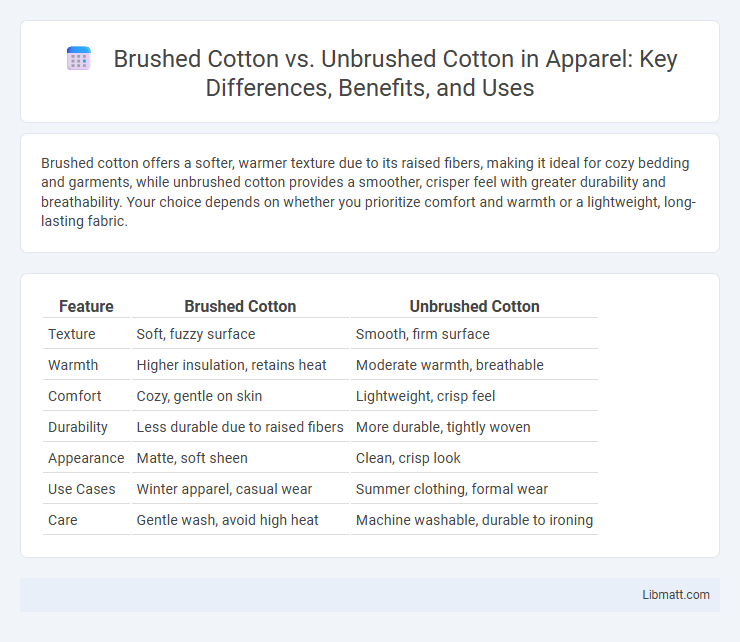Brushed cotton offers a softer, warmer texture due to its raised fibers, making it ideal for cozy bedding and garments, while unbrushed cotton provides a smoother, crisper feel with greater durability and breathability. Your choice depends on whether you prioritize comfort and warmth or a lightweight, long-lasting fabric.
Table of Comparison
| Feature | Brushed Cotton | Unbrushed Cotton |
|---|---|---|
| Texture | Soft, fuzzy surface | Smooth, firm surface |
| Warmth | Higher insulation, retains heat | Moderate warmth, breathable |
| Comfort | Cozy, gentle on skin | Lightweight, crisp feel |
| Durability | Less durable due to raised fibers | More durable, tightly woven |
| Appearance | Matte, soft sheen | Clean, crisp look |
| Use Cases | Winter apparel, casual wear | Summer clothing, formal wear |
| Care | Gentle wash, avoid high heat | Machine washable, durable to ironing |
Introduction to Brushed and Unbrushed Cotton
Brushed cotton features a soft, fuzzy surface achieved by gently raising the fibers, enhancing warmth and comfort, ideal for cozy bedding and apparel. Unbrushed cotton retains its smooth, natural texture, offering breathability and durability suitable for everyday wear and lightweight linens. Understanding these differences helps you select the perfect fabric for your comfort and style needs.
What is Brushed Cotton?
Brushed cotton is a type of cotton fabric that has been mechanically brushed to lift the fibers and create a soft, fuzzy texture on one or both sides of the material. This process enhances the fabric's warmth and comfort, making it ideal for clothing and bedding designed for cooler weather. Your choice of brushed cotton offers a cozy, plush feel compared to unbrushed cotton, which retains a smoother, less textured surface.
What is Unbrushed Cotton?
Unbrushed cotton is fabric made from cotton fibers that have not undergone the brushing process, leaving the surface smooth and tightly woven. This type of cotton retains a crisp texture, making it more durable and less prone to pilling compared to brushed cotton. Choosing unbrushed cotton ensures your clothing or bedding feels cool and firm, ideal for those who prefer a sleek, clean finish.
Manufacturing Process Differences
Brushed cotton undergoes an extra finishing process where fine brushes gently lift fibers from the fabric surface, creating a soft, fuzzy texture ideal for warmth and comfort. Unbrushed cotton skips this step, retaining a smoother, crisper feel due to the lack of fiber agitation. This distinction in manufacturing results in brushed cotton being more insulating and cozy, while unbrushed cotton features greater durability and breathability.
Texture and Feel: Brushed vs Unbrushed Cotton
Brushed cotton features a soft, fuzzy texture created by gently raising the fibers, offering a warm and cozy feel ideal for colder climates. Unbrushed cotton has a smooth, crisp surface that feels lighter and cooler against the skin, making it perfect for warmer weather. Your choice between brushed and unbrushed cotton depends on your preference for softness versus breathability.
Warmth and Breathability Comparison
Brushed cotton offers enhanced warmth due to its raised fibers that trap heat more effectively, making it ideal for cooler temperatures. Unbrushed cotton maintains superior breathability because its smooth surface allows air to circulate freely, keeping you cooler and more comfortable in warmer conditions. Choosing between brushed and unbrushed cotton depends on your need for thermal insulation versus airflow for optimal comfort.
Durability and Care Requirements
Brushed cotton features a soft, raised nap that increases comfort but may reduce long-term durability compared to unbrushed cotton, which retains a tighter weave and resists wear and tear more effectively. Unbrushed cotton demands less delicate care, often withstanding frequent washing and high temperatures without significant damage, while brushed cotton requires gentler washing cycles to maintain its softness and prevent pilling. Your choice should balance the desired texture against maintenance preferences, with unbrushed cotton better suited for durability and ease of care.
Common Uses and Applications
Brushed cotton is commonly used for cozy clothing items such as flannel shirts, pajamas, and bedding due to its soft, warm texture resulting from the raised fibers. Unbrushed cotton, known for its smooth and breathable qualities, is favored for lightweight summer apparel, shirts, and casual wear where comfort and durability are essential. Both types serve distinct functions in fashion and home textiles, with brushed cotton providing warmth and softness while unbrushed cotton offers breathability and crispness.
Eco-Friendliness and Sustainability
Brushed cotton undergoes extra processing that gently lifts the fabric fibers, creating a soft texture but often increasing water and energy consumption compared to unbrushed cotton. Unbrushed cotton retains its natural weave and requires less manufacturing, making it generally more eco-friendly by reducing chemical use and waste. Choosing unbrushed cotton supports sustainability efforts through lower environmental impact during production and enhanced biodegradability.
Choosing the Right Cotton for Your Needs
Brushed cotton offers a soft, warm texture ideal for cozy clothing and bedding, while unbrushed cotton provides a smoother, more durable fabric suited for everyday wear and utilitarian purposes. Your choice depends on whether comfort or durability is your priority; brushed cotton excels in softness and insulation, whereas unbrushed cotton maintains breathability and resilience. Selecting the right type affects the fabric's feel, performance, and suitability for different climates or activities.
Brushed Cotton vs Unbrushed Cotton Infographic

 libmatt.com
libmatt.com